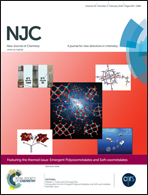A facile and fast synthetic approach to create selenium nanoparticles with diverse shapes and their antioxidation ability†
Abstract
A synthetic method is proposed to produce nanostructures simply with diverse morphology and dimensions, which plays a critical role in the development of nanoscience and technology. Herein, a microwave-assisted approach is presented for the facile and fast synthesis of different selenium nanostructures including nanoball, nanotube and multi-armed nanorod, by reducing H2SeO3 with L-asparagine in polyethylene glycol (PEG200) for half an hour. The results showed that the diameter and morphology of selenium nanoparticles were controlled by the L-asparagine/H2SeO3 concentration ratio and the microwave irradiation time. Interestingly, morphology was changed from amorphous spherical nanoball to trigonal nanotube during the synthetic process. The morphology and chemical composition of products were characterized by spectroscopic and microscopic methods. Moreover, the DPPH and ABTS scavenging analysis of the amorphous selenium nanoball revealed that the nanoparticles with smaller diameters showed the stronger antioxidant activity. The cell viability assay showed that the amorphous selenium nanoball demonstrated low toxicity on the model cells. Our synthetic method provides a useful strategy to develop potential applications of selenium nanostructures on a large scale.


 Please wait while we load your content...
Please wait while we load your content...